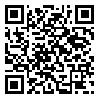Volume 29, Issue 6 (Monthly_Sep 2018)
Studies in Medical Sciences 2018, 29(6): 421-427 |
Back to browse issues page
Download citation:
BibTeX | RIS | EndNote | Medlars | ProCite | Reference Manager | RefWorks
Send citation to:



BibTeX | RIS | EndNote | Medlars | ProCite | Reference Manager | RefWorks
Send citation to:
Valizade Hasanloei M A, Motarjemizadeh G, Pakzad S, Asghari M. Exposure keratitis in mechanical ventilatory patients admitted to intensive care unit . Studies in Medical Sciences 2018; 29 (6) :421-427
URL: http://umj.umsu.ac.ir/article-1-4423-en.html
URL: http://umj.umsu.ac.ir/article-1-4423-en.html
Urmia university of medical sciences , aminvalizade@yahoo.com
Abstract: (5141 Views)
Background & Aims: Exposure Keratitis (EK) is a common problem in critically ill patients admitted to the Intensive Care Unit (ICU). We conducted exposure keratitis in mechanical ventilatory patients in the intensive care unit of Imam Khomeini Hospital in Urmia for five years.
Materials & Methods: In this retrospective cross-sectional study, the records of the patients were taken from the medical records unit of the hospital and also the demographic characteristics, patients’ consciousness level (GCS), APACHE II score, PCO2 from arterial blood gases, exposure keratitis, duration of mechanical ventilation and hospitalization in the intensive care unit, and the mortality of patients were extracted and entered into a checklist. Patients with GCS ≤12 were enrolled in the study and patients with GCS ≥ 13and=3 were excluded. At the end of the study, T-test, Chi-Square test, and Fisher exact test were used to analyze the data. P<0.05 was considered statistically significant.
Results: The frequency of exposure keratitis was 33.4%. There was a significant difference between patients in term of their genders, the levels of consciousness (GCS), APACHE II, duration of mechanical ventilation and hospitalization in the intensive care unit, mortality rate, and the frequency of exposure keratitis (P<0.05). However, there was no significant difference between patients in term of the mean age, PaCO2 and the frequency of exposure keratitis (P>0.05).
Conclusion: The frequency of exposure keratitis was expected in our study. Moreover, the most common factor was the low-level of consciousness and the patients’ age group.
Materials & Methods: In this retrospective cross-sectional study, the records of the patients were taken from the medical records unit of the hospital and also the demographic characteristics, patients’ consciousness level (GCS), APACHE II score, PCO2 from arterial blood gases, exposure keratitis, duration of mechanical ventilation and hospitalization in the intensive care unit, and the mortality of patients were extracted and entered into a checklist. Patients with GCS ≤12 were enrolled in the study and patients with GCS ≥ 13and=3 were excluded. At the end of the study, T-test, Chi-Square test, and Fisher exact test were used to analyze the data. P<0.05 was considered statistically significant.
Results: The frequency of exposure keratitis was 33.4%. There was a significant difference between patients in term of their genders, the levels of consciousness (GCS), APACHE II, duration of mechanical ventilation and hospitalization in the intensive care unit, mortality rate, and the frequency of exposure keratitis (P<0.05). However, there was no significant difference between patients in term of the mean age, PaCO2 and the frequency of exposure keratitis (P>0.05).
Conclusion: The frequency of exposure keratitis was expected in our study. Moreover, the most common factor was the low-level of consciousness and the patients’ age group.
Type of Study: Research |
Subject:
Anesthesia
Send email to the article author
| Rights and permissions | |
 |
This work is licensed under a Creative Commons Attribution-NonCommercial 4.0 International License. |






